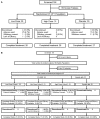Phase 2 studies of oral hypoxia-inducible factor prolyl hydroxylase inhibitor FG-4592 for treatment of anemia in China
- PMID: 28371815
- PMCID: PMC5837707
- DOI: 10.1093/ndt/gfx011
Phase 2 studies of oral hypoxia-inducible factor prolyl hydroxylase inhibitor FG-4592 for treatment of anemia in China
Abstract
Background: FG-4592 (roxadustat) is an oral hypoxia-inducible factor (HIF) prolyl hydroxylase inhibitor (HIF-PHI) promoting coordinated erythropoiesis through the transcription factor HIF. Two Phase 2 studies were conducted in China to explore the safety and efficacy of FG-4592 (USAN name: roxadustat, CDAN name: ), a HIF-PHI, in patients with anemia of chronic kidney disease (CKD), both patients who were dialysis-dependent (DD) and patients who were not dialysis-dependent (NDD).
Methods: In the NDD study, 91 participants were randomized to low (1.1-1.75 mg/kg) or high (1.50-2.25 mg/kg) FG-4592 starting doses or to placebo. In the DD study, 87 were enrolled to low (1.1-1.8 mg/kg), medium (1.5-2.3 mg/kg) and high (1.7-2.3 mg/kg) starting FG-4592 doses or to continuation of epoetin alfa. In both studies, only oral iron supplementation was allowed.
Results: In the NDD study, hemoglobin (Hb) increase ≥1 g/dL from baseline was achieved in 80.0% of subjects in the low-dose cohort and 87.1% in the high-dose cohort, versus 23.3% in the placebo arm (P < 0.0001, both). In the DD study, 59.1%, 88.9% (P = 0.008) and 100% (P = 0.0003) of the low-, medium- and high-dose subjects maintained their Hb levels after 5- and 6-weeks versus 50% of the epoetin alfa-treated subjects. In both studies, significant reductions in cholesterol were noted in FG-4592-treated subjects, with stability or increases in serum iron, total iron-binding capacity (TIBC) and transferrin (without intravenous iron administration). In the NDD study, hepcidin levels were significantly reduced across all FG-4592-treated arms as compared with no change in the placebo arm. In the DD study, hepcidin levels were also reduced in a statistically significant dose-dependent manner in the highest dose group as compared with the epoetin alfa-treated group. Adverse events were similar for FG-4592-treated and control subjects.
Conclusions: FG-4592 may prove an effective alternative for managing anemia of CKD. It is currently being investigated in a pivotal global Phase 3 program.
Keywords: FG-4592; anemia in chronic kidney disease; erythropoiesis; erythropoietin; hypoxia-inducible factor.
© The Author 2017. Published by Oxford University Press on behalf of ERA-EDTA.
Figures



References
-
- US Center for Disease Control. National Chronic Kidney Disease Fact Sheet2014. http://www.cdc.gov/diabetes/pubs/pdf/kidney_factsheet.pdf (9 July 2016, date last accessed)
-
- Zhang L, Wang F, Wang L. et al. Prevalence of chronic kidney disease in China: a cross-sectional survey. Lancet 2012; 379: 815–822 - PubMed
-
- Collins AJ, Ma JZ, Xia A. et al. Trends in anemia treatment with erythropoietin usage and patient outcomes. Am J Kidney Dis 1998; 32: S133–S141 - PubMed
-
- Levin A. The treatment of anemia in chronic kidney disease: understandings in 2006. Curr Opin Nephrol Hypertens 2007; 16: 267–271 - PubMed
Publication types
MeSH terms
Substances
LinkOut - more resources
Full Text Sources
Other Literature Sources
Medical

